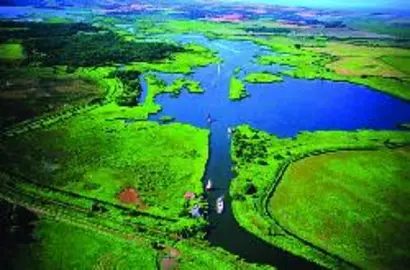Watching the world’s water from above: Scientists developed a Digital Atlas of the Earth’s Water System
March 13, 2008.
A small group of scientists, members of the International Project Office of the Global Water System Project (GWSP), located at the Center for Development Research of the University of Bonn (ZEF) in Germany, did an amazing job. They developed a global Digital Water Atlas.
Driven by the key overarching question of how human actions change the Global Water System and what the environmental and socio-economic feedbacks are that arise from these changes in the Global Water System, the scientists developed the Digital Water Atlas as a first step to answering it. “Unlike water-related atlases that are already available, the GWSP Atlas’ focus is on clarifying the inter-linkages of the elements and changes in the state of the Global Water System by creating a consistent set of annotated maps”, explains Marcel Endejan, project leader of the Digital Water Atlas. “It also takes into account the effects of global change and looks at different time scales including future scenarios of the Global Water System. We take a multi- and inter-disciplinary approach by using indicators from various scientific disciplines, including hydrology, biology, biogeochemistry, ecology, and sociology”.
The Atlas focuses on maps with global coverage. More detailed information may be provided for hot spot regions and for results of regional case studies at the next phase of the project. “Comparing regional case studies results with global analysis is part of the quality control”, says Lydia Dümenil Gates, Head of the GWSP Project Office in Bonn. “The documentation of the maps also includes information about the datasets used to prepare the map – the so-called metadata. Providing such metadata for each map contributes to the high scientific quality of the Atlas. The maps of the Atlas are not only based on simulation models but also on statistics and measurements such as remote sensing. Mapping the accuracies and uncertainties associated with maps will eventually improve the quality and applicability of the information provided by the Atlas. Besides, the process of building consensus on the mapped indicators and the interpretation of maps will stimulate further discussion among different scientific disciplines”, Gates concludes.
The International Project Office of the GWSP is coordinating the project, hosts the infrastructure and is responsible for the development and maintenance of the Digital Water Atlas. The datasets for preparing the maps and the map descriptions are provided by members of the GWSP community. The Digital Water Atlas is the first part of a more comprehensive Information System on global water issues. The development of the Atlas is linked with the ‘Global Water System Lexicon’, which is another GWSP activity led by the International Project Office, and the development of a conceptual framework of the Global Water System.
How to get involved
The content of the Digital Water Atlas is available online at http://atlas.gwsp.org with free and open access. Registered users can also download and use the datasets used to produce the maps. The GWSP Digital Water Atlas is a community driven project. If you wish to comment on maps and datasets provided through the Atlas, see any other maps included, or wish to provide additional global maps and datasets please contact the GWSP.
Contact
If you are interested in getting involved in developing the Digital Water Atlas or if you have any questions please contact the International Project Office of the GWSP.
e-mail: gwsp.ipo@uni-bonn.de
http://atlas.gwsp.org/


